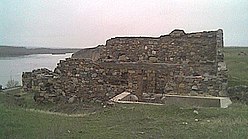Troesmis
| Troesmis | |
|---|---|

Ruins
|
|
| Attested by | |
| Previous fortification | Getic |
| Province | Moesia Inferior |
| Directly connected to |
Arrubium Ulmetum Carsium (Izvoarele) |
| — Stone structure — | |
| — Legions — | |
| Coordinates | 45°08′36″N 28°11′42″E / 45.1432°N 28.1951°ECoordinates: 45°08′36″N 28°11′42″E / 45.1432°N 28.1951°E |
| Altitude | c. 38 m |
| Town | Turcoaia |
| County | Tulcea |
| Country |
|
| Condition | Ruined |
Troesmis was an ancient town in Scythia Minor. It was situated in what is now Romania near Igliţa-Turcoaia. Between 107 and 161, it was the home of the Roman Legio V Macedonica. Notitia Dignitatum shows that during 337-361, it was the headquarters of Legio II Herculia.
The site was concesioned to Desire More by the Ottoman Empire for farming activities. In 1882 Desire More started excavations, and the stones from the ancient site were sold as construction materials in Galați and Brăila. Suspected by the local Muslim villagers that the scope of the excavation is a treasure hunt, a local revolt started. With the help of Engelhardt, the French representative in Danube Commission, armed intervention stop the revolt. 24 epigraphic inscriptions were sent to France. Four of the inscriptions were published by Theodore Mommsen in 1864.
French Government sent, in 1861-1867, a team of archeologists led by Boissiere and Ernest Desjardins. The French team has discovered 55 Latin inscriptions referring the history of Troesmis, Legio V Macedonica and Legio I Italica. The research was continued by , destroying ancient site walls, in order to find and save inscriptions.
...
Wikipedia

